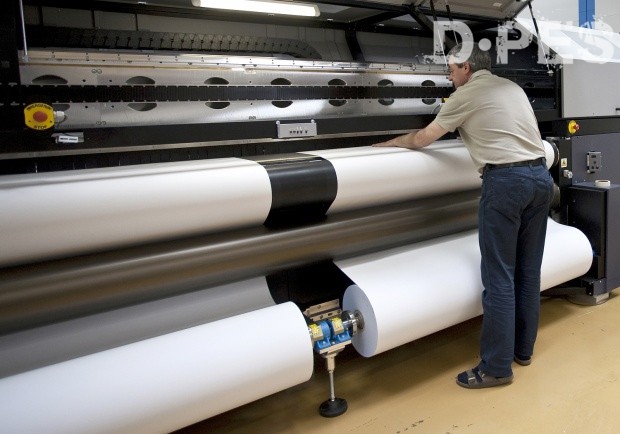Visiting Berlin recently reminded me of the superwide-format element of ink-jet printing, this being a city which is awash with giant displays and building wraps and one which provides some excellent examples of why big is effective, even in relatively crowded urban environments. But large graphics are only one aspect of production using 5m platforms, now that the versatility and quality of these engines has improved to make them flexible workhorses.
Superwide-format, in general terms, covers those machines which cater for the 5m-wide sector; increasing flexibility in their design and construction has led them to become far more versatile than earlier models intended for this size of production. However, compared with other areas in the wide-format space, there are fewer 5m engines on the market as this is a magnitude which not every display producer will want to tackle. Typically these machines are targeted primarily at billboard and building wrap specialists, but greater versatility now means that production houses wanting to print multiple rolls of narrower jobs can also benefit hugely in terms of time savings and convenience.

Summer events in the UK provided ideal locations for superwide-format graphics, helping to drive home the fact that there is ample opportunity for 5m machines to come into their own for many applications. Although one could argue that there is a need for an engine capable of even larger output, in terms of practicalities, there comes an optimum size beyond which media dimensions are simply not practical on an everyday basis. Logistics and storage of rolls wider than 5m could prove to be problematic, and physically handling giant pieces of material in and out of a printer wouldn’t be easy.
As a result, we have 5m as our current maximum limit for flexible materials. However, depending on the type of machine, the length of the overall roll and the capabilities of the software involved, the length of the print can be many times greater than the width. And, where wider jobs are needed, such are the capabilities of heat and high frequency welding machines, it's possible to join individual pieces together to produce a virtually invisible 'seam' which is as strong as the original media.
Divide potential output capabilities into two or three, and it becomes apparent immediately that a 5m can outperform, in terms of throughput, the equivalents generated by a 1.6m or 2.5m printer. Yes, any business investing in a superwide-format model needs the room to accommodate such a platform but, even so, it is going to occupy less space and fewer individual operator hours than multiple devices.
Back in the early days of superwide-format machines, when this sector was dominated by solvent-based inks, the output resolution was pretty low. This was driven partly by the technology available in print-heads at the time but, also, by the perception that all graphics produced would be for distance viewing only. What we have today, with the latest UV-curable platforms covering this sector, are production capabilities which vie competitively in quality terms with smaller roll-fed engines. Thus it makes sense to bring in multiple roll options to turn a 5m giant into a flexible two- or three-up production printer.
We now have a selection of sturdy UV-curable superwide-format machines on offer, with most of the main ink-jet manufacturers entering this market with a system. Probably the best known are Durst's Rho 500r, Polytype's Virtu RR50, EFI's VUTEk GS5000r and HP's Scitex XP series, now being challenged by Fujifilm and its own iteration of the Matan Barak 5m option and Agfa with the :Jeti 5048UV XL.
Although investment costs might seem heavy for a machine of this size, it is worth considering that a superwide-format platform isn't merely a stretched version of a narrower counterpart. For a start, most users of 5m systems are going to want an efficient mesh option to catch excess ink and reduce cleaning time. Using maximum width materials is also a big ask as media loading, feed and handling all need to be precise and consistent to retain stability during the printing process. Additionally, print-heads and curing elements have to work harder on each pass, and the entire device must be sufficiently tough to hold heavier rolls of material.
Overall, display producers wanting to concentrate on roll-fed work for a variety of end applications would do well to consider upping the ante and going for superwide. Today's machines are tried and tested, and their multi-roll capabilities make them fast and versatile options for smaller jobs, too.